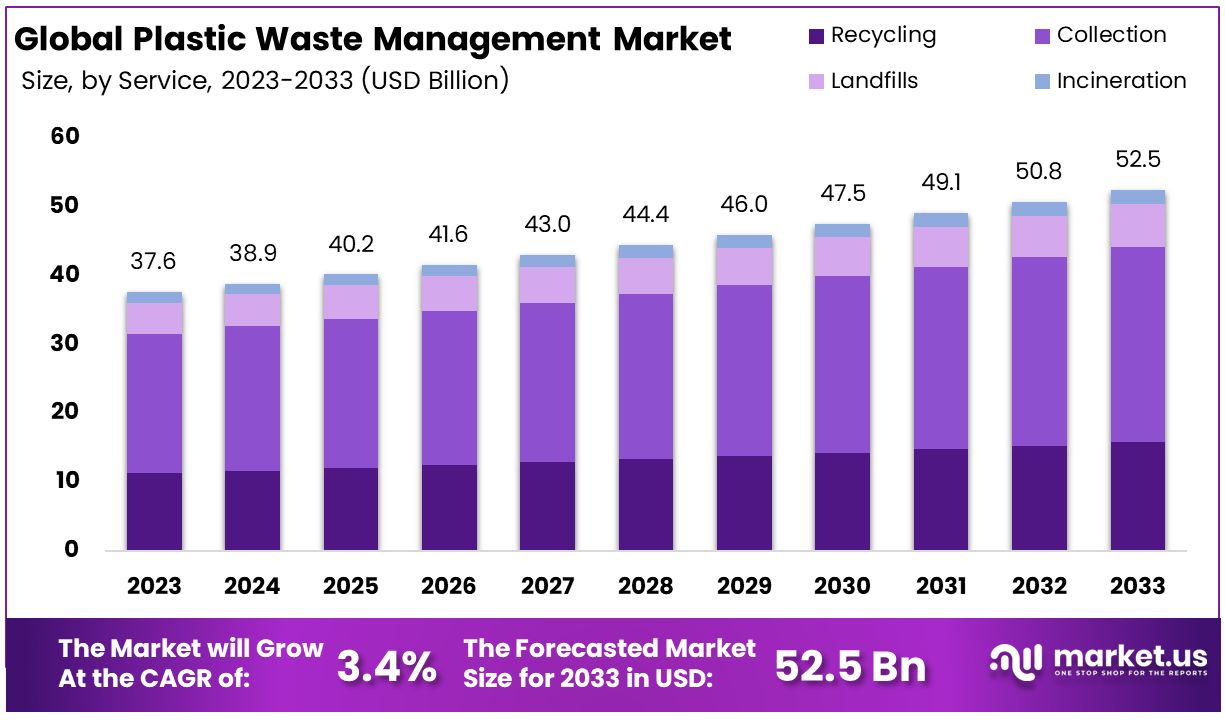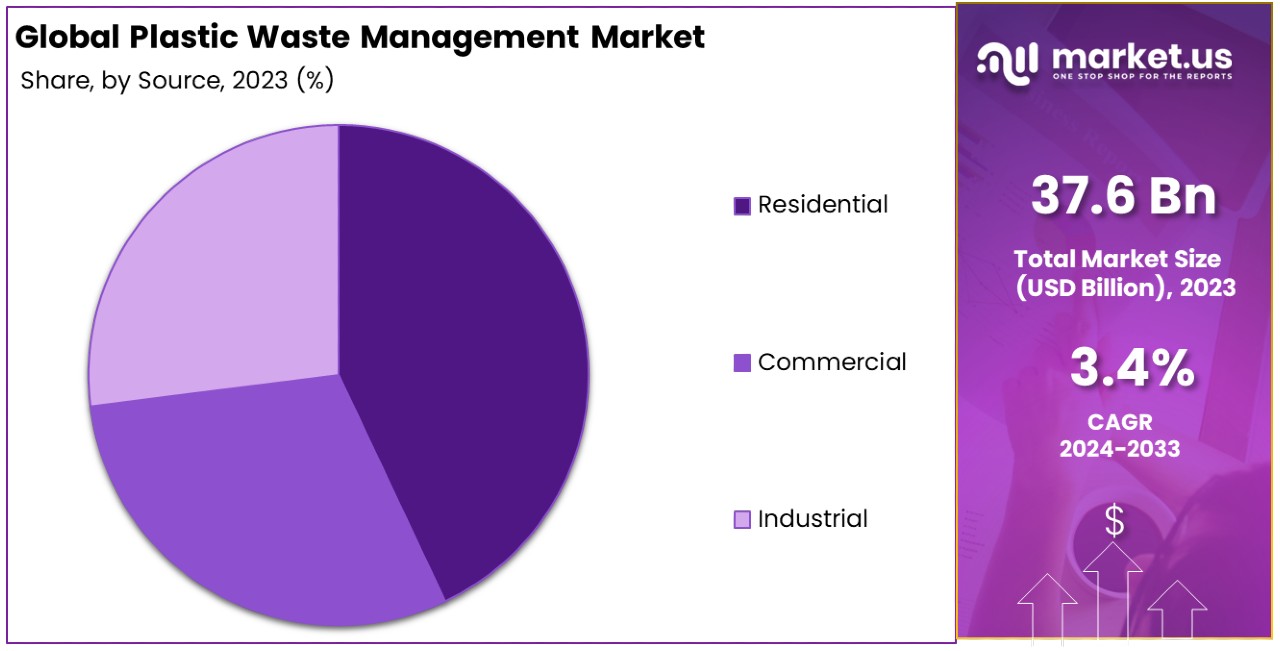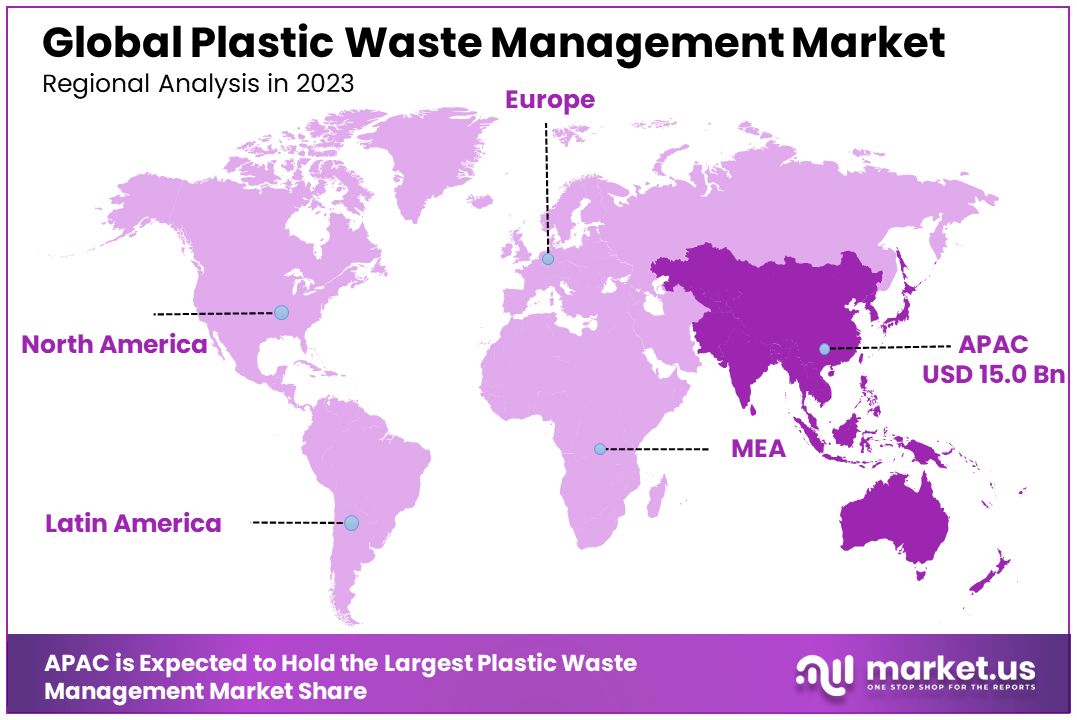Plastic Waste Management Market Report By Service (Collection, Recycling, Landfills , Incineration), By Material (Polypropylene , Low-density Polyethylene (LDPE), High-density Polyethylene (HDPE), Polyvinyl Chloride (PVC), Polyurethane (PUR), Other Materials), By Source, By End-user, By Region and Companies - Industry Segment Outlook, Market Assessment, Competition Scenario, Trends and Forecast 2024-2033
- Published date: March 2024
- Report ID: 18173
- Number of Pages: 255
- Format:
- keyboard_arrow_up
Quick Navigation
Report Overview
The Global Plastic Waste Management Market size is expected to be worth around USD 52.5 Billion by 2033, from USD 37.6 Billion in 2023, growing at a CAGR of 3.40% during the forecast period from 2024 to 2033.
The Plastic Waste Management Market encompasses strategies and services aimed at reducing, recycling, and reusing plastic waste. This market addresses the growing concern over plastic pollution, impacting both the environment and public health.
Businesses in this sector offer solutions such as recycling services, waste collection, and advanced processing technologies to convert plastic waste into reusable materials. The focus is on creating sustainable practices to manage the lifecycle of plastics, supporting global efforts towards a circular economy.

In the landscape of environmental sustainability, the Plastic Waste Management Market is emerging as a critical area of focus for industry leaders. This market, integral to global sustainability efforts, involves the strategic reduction, recycling, and repurposing of plastic waste to mitigate environmental impact and promote a circular economy.
The pivotal role of this market is underscored by its response to increasing regulatory pressures, consumer demand for sustainable products, and corporate responsibility initiatives.
Recent research highlights a parallel and noteworthy trend in the automotive industry that indirectly influences the Plastic Waste Management Market. A comprehensive study by European Aluminium, executed by Ducker Carlisle, reveals a significant surge in the use of aluminium within European vehicles, marking an 18% increase from 174 kg in 2019 to 205 kg in 2022.
This upward trajectory is expected to continue, with projections indicating a rise to 237 kg by 2026, and further to 256 kg per vehicle by 2030. The North American market echoes this trend, anticipating an average of 570 pounds of aluminum per light vehicle by 2030.
These findings carry profound implications for the Plastic Waste Management Market. The shift towards aluminium, prized for its recyclability and lightweight nature, underscores a broader industry move towards sustainable materials.
This transition not only reflects on the automotive sector’s commitment to reducing carbon footprints but also signals a potential increase in demand for sophisticated waste management solutions. As industries pivot towards materials like aluminium, the Plastic Waste Management Market must adapt, innovating in recycling technologies and strategies to handle an evolving waste composition.
Key Takeaways
- Market Value Projection: The market is anticipated to reach approximately USD 52.5 Billion by 2033, showing growth from USD 37.6 Billion in 2023, with a CAGR of 3.40%.
- Service Analysis: Recycling is the primary service segment, constituting around 30% of the market, driven by global sustainability efforts and technological advancements enhancing recycling efficiency.
- Material Analysis: Low-density Polyethylene (LDPE) leads the materials segment with an 18% share, primarily used in packaging. Its recyclability potential and demand for recycled LDPE in manufacturing offer significant market opportunities.
- Source Analysis: Residential waste is the primary source, driven by daily consumption habits, emphasizing the need for tailored management strategies.
- End-user Analysis: The packaging sector commands a 45% share, driven by consumer preferences for sustainable packaging and regulatory pressures.
- Regional Dynamics: Asia Pacific dominates the market with a 40% share, driven by increasing plastic consumption and growing environmental concerns. Europe holds approximately 25% of the market, benefiting from stringent regulations and a well-established recycling industry.
- Analyst Viewpoint: Analysts anticipate steady growth in the plastic waste management market, driven by increasing environmental awareness, regulatory pressures, and corporate sustainability initiatives.
- Growth Opportunities: Opportunities lie in technological advancements in recycling processes, expanding recycling capabilities, and developing innovative solutions for managing different types of plastic waste. Additionally, there’s potential for market expansion through collaborations and partnerships to address the global plastic pollution crisis.
Driving Factors
Increasing Plastic Consumption Drives Market Growth
The escalation in global plastic production, directly linked to rising consumption, has significantly contributed to the expansion of the Plastic Waste Management Market. As the volume of plastic waste burgeons, the imperative for efficient management solutions intensifies. This scenario has catalyzed the demand for innovative waste management services and technologies.
Notably, collaborations between corporations like Adidas and IKEA with environmental organizations illustrate the burgeoning business opportunities within this sector. These partnerships, aimed at integrating recycled plastic waste into product lines, underscore the market’s potential for sustainable innovation and economic growth. This trend exemplifies the market’s capacity to adapt and evolve in response to increasing waste generation, highlighting a symbiotic relationship between environmental stewardship and economic opportunity.
Stringent Regulations Propel Market Expansion
The introduction of rigorous regulations and policies worldwide acts as a significant catalyst for the Plastic Waste Management Market’s growth. Initiatives such as bans on single-use plastics and the imposition of extended producer responsibility (EPR) schemes compel companies to invest in sustainable waste management practices.
The European Union’s ambitious Plastic Strategy, targeting the recyclability or reusability of all plastic packaging by 2030, exemplifies such regulatory pressures. These policies not only mandate compliance but also stimulate investment in recycling infrastructure, enhancing the market’s capacity for innovation and adaptation. This regulatory landscape fosters a conducive environment for the market’s expansion, driving technological advancements and infrastructure development in plastic waste management.
Technological Innovations Fuel Market Growth
Advancements in recycling technologies have revolutionized the Plastic Waste Management Market, making waste processing more efficient and economically feasible. Breakthroughs in chemical recycling, sophisticated sorting methods, and the creation of biodegradable plastics are pivotal to the industry’s growth.
These innovations not only enhance the efficiency of waste management but also open new avenues for material reuse, aligning with the principles of a circular economy. The synergy between technological advancements and market expansion is evident, as each innovation bolsters the market’s capability to address the challenges of plastic waste. This dynamic illustrates how technological progress is integral to the market’s evolution, driving sustainable practices and fostering economic resilience.
Restraining Factors
Lack of Standardization Restrains Market Growth
The absence of universally accepted policies and regulations significantly impedes the Plastic Waste Management Market. Diverse regulations across countries and regions lead to a fragmented market, complicating compliance efforts for businesses operating internationally. This lack of standardization makes it challenging to develop solutions that are efficient on a global scale, stymieing innovation and scalability.
The inconsistency in regulatory frameworks not only complicates the operational landscape for waste management companies but also deters investment in the sector, limiting market growth and the development of universally applicable, efficient waste management practices.
Technological Limitations Hinder Market Expansion
Technological challenges, particularly in recycling complex plastics like multi-layered or contaminated materials, severely limit the Plastic Waste Management Market’s growth. These types of plastics present significant obstacles due to their intricate composition and the complexities involved in material separation.
Furthermore, the recycling process often leads to a degradation in plastic quality, restricting the potential for recycled materials to replace virgin plastics in various applications. This limitation not only affects the market’s ability to manage waste effectively but also reduces the economic viability of recycling solutions, constraining the industry’s growth and its potential to contribute to a circular economy.
Service Analysis
In the domain of the Plastic Waste Management Market, the service segment encapsulates a range of solutions aimed at mitigating the environmental impact of plastic waste. Among these, recycling emerges as the dominant sub-segment, accounting for approximately 30% of the market. This prominence is attributed to the increasing global push towards sustainability, with recycling serving as a cornerstone for efforts to reduce plastic pollution and encourage the reuse of materials.
The recycling segment’s growth is fueled by advancements in technology, which enhance the efficiency of recycling processes and expand the types of plastics that can be recycled. Furthermore, stringent regulations and public demand for sustainable practices have bolstered the recycling sector, making it a focal point for investments within the market.
Other critical services in the Plastic Waste Management Market include collection, landfills, and incineration. Collection services form the foundation of waste management, ensuring efficient segregation and transportation of plastics to recycling centers or disposal facilities. Landfills, while increasingly seen as less favorable due to their environmental footprint, remain a significant segment due to the ongoing challenge of non-recyclable waste.
Incineration, offering both waste reduction and energy recovery options, plays a complex role. It is leveraged in regions where landfill space is scarce and is viewed through the lens of energy recovery, despite concerns over emissions and the loss of recyclable materials.
Material Analysis
Within the materials spectrum of the Plastic Waste Management Market, Low-density Polyethylene (LDPE) stands out as the leading sub-segment, commanding an 18% share. LDPE’s dominance is largely due to its widespread use in packaging, from plastic bags to films and containers, making it a significant contributor to plastic waste.
Its resilience, flexibility, and affordability have cemented its role in various applications, underscoring the urgency for effective LDPE waste management solutions. The focus on LDPE in the recycling sector is driven by the material’s recyclability potential and the high demand for recycled LDPE in manufacturing, signaling a substantial market opportunity for waste management companies.
The market also engages with other materials such as Polypropylene (PP), High-density Polyethylene (HDPE), Polyvinyl Chloride (PVC), Polyurethane (PUR), and a variety of other plastics. Each of these materials presents unique challenges and opportunities for waste management. For instance, PP and HDPE are valued for their recyclability and are commonly used in consumer goods, making them crucial targets for recycling initiatives.
PVC and PUR, on the other hand, pose more significant challenges due to their chemical composition and the complexities involved in their recycling processes. The “Other Materials” category encompasses a broad array of plastics, each requiring specialized management strategies to minimize environmental impact. This diversity highlights the need for tailored approaches in the Plastic Waste Management Market, underscoring the importance of innovation and regulatory adaptability in tackling the nuances of plastic waste.
Source Analysis
In the Plastic Waste Management Market, the “Source” segment delineates the origin of plastic waste, categorized into commercial, industrial, and residential sources. Among these, the residential source stands out significantly. This predominance is attributed to the daily consumption and disposal habits of households, which generate a substantial volume of plastic waste. Items ranging from packaging materials to disposable products contribute to this stream, emphasizing the critical need for effective management strategies tailored to residential waste characteristics.
Commercial and industrial sources, while differing in their waste composition and volume, play crucial roles in the market’s dynamics. Commercial waste, generated by entities such as retail outlets, offices, and restaurants, often includes packaging, food service items, and office supplies. Industrial waste, on the other hand, comprises bulkier plastic items from manufacturing processes, construction sites, and agricultural activities. Each source requires distinct approaches for collection, segregation, and processing, underlining the market’s need for diverse and adaptable waste management solutions.

End-user Analysis
The “End-user” segment of the Plastic Waste Management Market captures the sectors where recycled plastics are ultimately utilized. The packaging sector, commanding a 45% share, is the most dominant, reflecting the extensive use of plastics in wrapping, protecting, and preserving products. This sector’s demand for recycled plastics is driven by consumer preferences for sustainable packaging solutions, regulatory pressures, and corporate sustainability goals. The high volume of plastic waste originating from packaging underscores its pivotal role in recycling and waste management efforts.
Other significant end-user segments include transportation, building and construction, electrical and electronics, textile, and a broad category of other end-users. Each of these sectors incorporates recycled plastics into various applications, contributing to the circular economy. The transportation sector, for example, uses recycled plastics in components to reduce vehicle weight and improve fuel efficiency. In building and construction, recycled plastics find use in panels, insulation, and piping, enhancing the sustainability of structures. The electrical and electronics sector incorporates recycled plastics in housings and components, while the textile industry uses them in the production of synthetic fibers.
Key Market Segments
By Service
- Collection
- Recycling
- Landfills
- Incineration
By Material
- Polypropylene
- Low-density Polyethylene (LDPE)
- High-density Polyethylene (HDPE)
- Polyvinyl Chloride (PVC)
- Polyurethane (PUR)
- Other Materials
By Source
- Commercial
- Industrial
- Residential
By End-user
- Packaging
- Transportation
- Building & Construction
- Electrical & Electronics
- Textile
- Other End-users
Growth Opportunities
Advanced Recycling Technologies Offer Growth Opportunity
The development of advanced recycling technologies, including chemical and enzymatic recycling methods, represents a significant growth opportunity within the Plastic Waste Management Market. These innovations enable the efficient processing of complex and multi-layered plastics that traditional recycling methods cannot handle.
By breaking down plastics at the molecular level, these technologies can transform previously non-recyclable materials into high-quality raw materials, expanding the types of plastics that can be recycled. This breakthrough has the potential to significantly increase recycling rates, reduce reliance on virgin materials, and open new markets for recycled plastics, driving expansion in the waste management sector.
Waste-to-Energy Solutions Enhance Market Potential
Waste-to-energy processes, such as incineration, gasification, and pyrolysis, offer a compelling growth opportunity for the Plastic Waste Management Market, especially in areas facing landfill scarcity or lacking sophisticated recycling infrastructure. By converting non-recyclable plastic waste into energy, these technologies not only address the issue of waste disposal but also contribute to energy generation, presenting a dual benefit.
This approach provides an alternative revenue stream for waste management companies and supports the global shift towards sustainable energy solutions. As demand for sustainable and efficient waste management solutions grows, waste-to-energy technologies are poised to play a crucial role in market expansion, highlighting their potential as a key driver of growth in the industry.
Trending Factors
Circular Economy and EPR Are Trending Factors
The movement towards a circular economy and the adoption of Extended Producer Responsibility (EPR) schemes represent key trending factors in the Plastic Waste Management Market. These initiatives promote the sustainable management of plastics by encouraging manufacturers to design products with their lifecycle in mind, thereby reducing waste and facilitating recycling.
EPR schemes, in particular, hold producers accountable for the disposal of their products, encouraging them to innovate in product design and recycling methods. This shift is not only environmentally significant but also economically beneficial, as it opens up new opportunities for recycling and waste management businesses to collaborate with producers, driving market growth and innovation.
Increased Private Sector Involvement Trends Upward
The growing involvement of the private sector in the Plastic Waste Management Market is a significant trend, contributing to the sector’s expansion and the development of innovative solutions. Companies across various industries are partnering with governments and NGOs to tackle plastic waste, driven by consumer demand for sustainable practices and corporate social responsibility goals.
These collaborations are enhancing the market’s capacity to manage plastic waste effectively and are fostering the creation of advanced recycling technologies and infrastructure. The private sector’s commitment is not only elevating the market’s profile but also accelerating progress towards more sustainable waste management practices.
Digitalization and Smart Waste Management Lead Market Trends
Digitalization and the adoption of smart waste management technologies are emerging as leading trends in the Plastic Waste Management Market. The integration of IoT sensors, blockchain, and AI analytics into waste management processes enables more efficient operations, from collection and sorting to recycling.
These technologies provide real-time data and insights, improving the traceability of waste streams and enhancing decision-making. By streamlining operations and increasing transparency, digitalization is setting new standards for efficiency and sustainability in waste management, positioning the market for future growth and innovation.
Regional Analysis
Asia Pacific Dominates with 40% Market Share
The Asia Pacific region holds a commanding 40% share of the Plastic Waste Management Market, a testament to its significant influence and strategic importance in the global landscape. Several key factors contribute to this dominance, including high rates of plastic consumption and production, particularly in rapidly growing economies like China and India.
Additionally, the region’s commitment to improving recycling infrastructure and adopting innovative waste management technologies plays a critical role. Government policies and initiatives aimed at reducing plastic waste further drive market growth.
Market dynamics in the Asia Pacific are shaped by its vast population, urbanization, and industrialization, which generate a substantial volume of plastic waste. The region’s diverse economic landscape also presents unique challenges and opportunities in waste management, necessitating tailored solutions that can address the varied needs of its countries.

Market Share and Growth Rate in Other Regions
- North America: This region accounts for approximately 20% of the market. North America’s strong regulatory framework and advanced waste management infrastructure support its significant market share. Innovations in recycling technologies and sustainable materials are driving growth.
- Europe: Holding around 25% of the market, Europe benefits from stringent environmental regulations, a high level of public awareness, and a well-established recycling industry. The European Union’s aggressive targets for waste reduction and recycling are pivotal in driving the market forward.
- Middle East & Africa: With a smaller share of about 10%, this region’s market is growing due to increasing environmental concerns and investments in waste management infrastructure, particularly in Gulf Cooperation Council (GCC) countries.
- Latin America: Latin America has a market share of about 5%. Despite being a smaller player, there’s potential for growth driven by urbanization and improving regulatory frameworks focusing on sustainability and waste management.
Key Regions and Countries
- North America
- The US
- Canada
- Mexico
- Western Europe
- Germany
- France
- The UK
- Spain
- Italy
- Portugal
- Ireland
- Austria
- Switzerland
- Benelux
- Nordic
- Rest of Western Europe
- Eastern Europe
- Russia
- Poland
- The Czech Republic
- Greece
- Rest of Eastern Europe
- APAC
- China
- Japan
- South Korea
- India
- Australia & New Zealand
- Indonesia
- Malaysia
- Philippines
- Singapore
- Thailand
- Vietnam
- Rest of APAC
- Latin America
- Brazil
- Colombia
- Chile
- Argentina
- Costa Rica
- Rest of Latin America
- Middle East & Africa
- Algeria
- Egypt
- Israel
- Kuwait
- Nigeria
- Saudi Arabia
- South Africa
- Turkey
- United Arab Emirates
- Rest of MEA
Key Players Analysis
In the Plastic Waste Management Market, key players such as Veolia Environnement S.A., Waste Management Inc., Suez Environnement Company, Republic Services Inc., Clean Harbors, Inc., Stericycle, Biffa, and Remondis SE & Co. KG, are pivotal in shaping industry dynamics. These companies have established strong market positions through comprehensive waste management services, including collection, recycling, and advanced waste-to-energy solutions.
Their strategic focus on innovation and sustainability has led to the development of new recycling technologies and the implementation of eco-friendly practices. Their impact extends beyond service provision to influencing regulatory policies and driving global trends towards sustainable waste management. Through partnerships, investments in technology, and global operations, these key players significantly contribute to the industry’s growth, setting standards for operational excellence and environmental stewardship in the Plastic Waste Management Market.
Market Key Players
- Veolia Environnement S.A.
- Waste Management Inc.,
- Suez Environnement Company
- Republic Services Inc.
- Clean Harbors, Inc.
- Stericycle
- Biffa
- Remondis SE & Co. KG
Recent Developments
- On August 2023, PepsiCo’s plastic waste management program reached Agra, with the campaign being inaugurated by Ministry of State for Environment. The Ministry appreciated the initiative by PepsiCo and emphasized the importance of collective efforts in addressing the challenge of plastic pollution.
- On February 2024, scientists made a groundbreaking discovery of microbes in the Swiss Alps and the Arctic that have the potential to revolutionize plastic recycling. These microbes possess the unique ability to digest plastics without requiring excessive heat, offering a promising solution to the global plastic pollution crisis.
- On June 2023, New York-based sustainable health care company Cabinet Health launched a nationwide pill bottle recycling program to address pharmaceutical plastic waste. The program, which is open to anyone in the U.S., allows participants to request a recycling bag from Cabinet Health, ship back their old, empty plastic pill bottles for free.
Report Scope
Report Features Description Market Value (2023) USD 37.6 Billion Forecast Revenue (2033) USD 52.5 Billion CAGR (2024-2033) 3.40% Base Year for Estimation 2023 Historic Period 2018-2023 Forecast Period 2024-2033 Report Coverage Revenue Forecast, Market Dynamics, Competitive Landscape, Recent Developments Segments Covered By Service (Collection, Recycling, Landfills , Incineration), By Material (Polypropylene , Low-density Polyethylene (LDPE), High-density Polyethylene (HDPE), Polyvinyl Chloride (PVC), Polyurethane (PUR), Other Materials), By Source (Commercial, Industrial, Residential), By End-user (Packaging, Transportation, Building & Construction, Electrical & Electronics, Textile, Other End-users) Regional Analysis North America – The US, Canada, & Mexico; Western Europe – Germany, France, The UK, Spain, Italy, Portugal, Ireland, Austria, Switzerland, Benelux, Nordic, & Rest of Western Europe; Eastern Europe – Russia, Poland, The Czech Republic, Greece, & Rest of Eastern Europe; APAC – China, Japan, South Korea, India, Australia & New Zealand, Indonesia, Malaysia, Philippines, Singapore, Thailand, Vietnam, & Rest of APAC; Latin America – Brazil, Colombia, Chile, Argentina, Costa Rica, & Rest of Latin America; Middle East & Africa – Algeria, Egypt, Israel, Kuwait, Nigeria, Saudi Arabia, South Africa, Turkey, United Arab Emirates, & Rest of MEA Competitive Landscape Veolia Environnement S.A., Waste Management Inc.,, Suez Environnement Company, Republic Services Inc., Clean Harbors, Inc., Stericycle, Biffa, Remondis SE & Co. KG Customization Scope Customization for segments, region/country-level will be provided. Moreover, additional customization can be done based on the requirements. Purchase Options We have three licenses to opt for: Single User License, Multi-User License (Up to 5 Users), Corporate Use License (Unlimited User and Printable PDF) Frequently Asked Questions (FAQ)
What is the projected value of the Global Plastic Waste Management Market?The Global Plastic Waste Management Market is expected to reach around USD 52.5 Billion by 2033, growing from USD 37.6 Billion in 2023, at a CAGR of 3.40% during the forecast period from 2024 to 2033.
What does the Plastic Waste Management Market encompass?The Plastic Waste Management Market includes strategies and services aimed at reducing, recycling, and reusing plastic waste to address environmental concerns.
What are the primary services offered in the Plastic Waste Management Market?Recycling, waste collection, and advanced processing technologies are among the primary services offered in the Plastic Waste Management Market.
What is driving the growth of the recycling segment in the Plastic Waste Management Market?The growth of the recycling segment is fueled by advancements in technology, stringent regulations, and increasing public demand for sustainable practices.
 Plastic Waste Management MarketPublished date: March 2024add_shopping_cartBuy Now get_appDownload Sample
Plastic Waste Management MarketPublished date: March 2024add_shopping_cartBuy Now get_appDownload Sample - Veolia Environnement S.A.
- Waste Management, Inc.
- Suez Environnement Company
- Clean Harbors, Inc.
- Republic Services, Inc.
- Stericycle
- Biffa
- Remondis SE & Co. KG
- Other Key Players
- settingsSettings
Our Clients
| Single User $4,599 $3,499 USD / per unit save 24% | Multi User $5,999 $4,299 USD / per unit save 28% | Corporate User $7,299 $4,999 USD / per unit save 32% | |
|---|---|---|---|
| e-Access | |||
| Report Library Access | |||
| Data Set (Excel) | |||
| Company Profile Library Access | |||
| Interactive Dashboard | |||
| Free Custumization | No | up to 10 hrs work | up to 30 hrs work |
| Accessibility | 1 User | 2-5 User | Unlimited |
| Analyst Support | up to 20 hrs | up to 40 hrs | up to 50 hrs |
| Benefit | Up to 20% off on next purchase | Up to 25% off on next purchase | Up to 30% off on next purchase |
| Buy Now ($ 3,499) | Buy Now ($ 4,299) | Buy Now ($ 4,999) |












